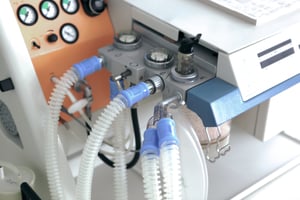In March and April 2020, the Food and Drug Administration (FDA) issued guidance aimed at expanding...
5 Labeling Changes that Require a New 510(k)
Medical device labeling changes are made for a wide array of reasons. When a manufacturer makes changes to the labeling for a medical device, they must assess the impact of the change against their 510(k) clearance. Some changes may require a new 510(k) submission. Others don't require a new 510(k) submission but will require thorough documentation of the changes.
Notably, the decision to change a medical device's labeling almost always has far-reaching consequences for manufacturing and marketing. If a labeling change for a Class II medical device requires a new 510(k), it will need more time and money than if the labeling change only requires documentation. While a change to the Indications for Use generally requires a 510(k) submission, it may also expand the marketing potential for the device once cleared.
- For example: if the Indications for Use of a catheter guidewire are modified to introduce several new capabilities on how users can access the types of vasculature previously not addressed in the labeling, a manufacturer will need to submit a new 510(k) submission that the FDA must evaluate for clearance. Once the agency clears the changes, the manufacturer can promote the device for these additional uses.
What Does Documentation Entail?
Device changes that don't trigger the regulatory threshold for new 510(k) submission must be documented. Documentation means providing a rationale for the manufacturer's action to submit new changes in a medical device. Ideally, you need to record consideration for each decision point and all the final decisions reached. The scope and type of documentation can vary, and if there is testing and other engineering analysis in part of the process, you need to reference or record the results during the documentation.
Is a New Submission Likely Required or Likely Not Required?
Instead of hard and fast rules, FDA gives only generalized guidance, saying that the below changes will "likely require" a new 510(k) instead of "must require" a new 510(k). If you are considering any changes on your device labeling as part of your regulatory tactics, you need to be familiar with all the changes that require a new submission and those that don't:
Label Changes Likely to Require a New 510(k)
Change made with the intent to significantly affect effectiveness or safety
Any changes that a manufacturer makes to a device that could affect its safety and effectiveness will definitely require a new submission according to the FDA guidance. Besides, even changes not intended to impact the devices' safety or effectiveness could still be evaluated to determine its impacts on safety and effectiveness. Such changes may therefore require the manufacturer to submit a new 510(k) filing.
Pro tip: Regardless of whether you intend for modifications to affect the effectiveness or safety of a device, you should conduct a risk-based assessment after the changes. A risk-based assessment helps determine whether device modifications introduce new risks. Such assessments are also essential when deciding whether a new 510(k) submission needs to be filed.
Change from single-use only to reusable
The FDA has since determined that a reusable device's performance and risks tend to differ substantially when the same device is labeled for single use only. Therefore, changing the device from single use only to reusable could significantly alter its safety and effectiveness. Consequently, a new 510(k) submission is required for such changes. However, changing a device labeled for reuse to single-use will generally not require a new submission.
Change from prescription (Rx) to over-the-counter (OTC) use
According to the FDA, changes related to the directions on how the device is used can significantly impact how users will use that device safely and effectively. This means that a change from prescription use only (Rx) to over-the-counter OTC use can significantly impact a device's safety and effectiveness. A new 510(k) submission will be required before such changes are implemented.
Changes that describe a new condition, disease, and patient demographic
Additionally, changes that describe a new disease, condition, or patient demographic that the device is meant for use in preventing, diagnosing, treating, curing, or controlling may also require a new 510(k) submission. The FDA may consider such changes to have the potential to significantly affect the safety and effectiveness of a medical device.
For example, if a recent cleared patient population for a device use includes persons with stage 4 cancer, and the manufacturer makes modifications to add persons with stage 3 cancer, a new submission will be required. Such modifications can affect the device's safety and effectiveness, and risk-based assessment should be conducted to identify new risks and determine if existing risks are significantly modified.
Changes in user or use environment
Changes in the device user or use environment can alter a device's risk profile. For example, a change from professional use to home use will likely affect the safety and effectiveness of a device. Such a change will require the submission of a new 510(k), as different environments have diverse environmental challenges and need different supervision levels. Likewise, a manufacturer that introduces changes on health care providers with varying training levels on specific devices will need a new submission since varying training levels can affect the device's risk profile.
Adding or deleting a contraindication
Changes that add or delete contraindication definitely require a new 501(k) submission. Ideally, the FDA considers any changes in specified contraindications for device use to possibly impact the safety or effectiveness of a device and must be reviewed by Agency. Ideally, before manufacturers delete or make modifications of contraindication, they should first make a new 510(k) submission because such labeling changes alter the indications for use in a manner that could substantially halter the safety or effectiveness of the specific device.
Label Changes Likely to Not Require a new 510(k)
- Change to device name- change to device name or description that doesn't affect the cleared indications for use does not require submission of a new 501(k), as such changes don't significantly affect the safety or effectiveness of the device.
- Change to improve readability or clarity – any change intended for clarity or improvement of readability consistent with a created indication of use does not require a new 501(k) submission.
- Change describing a new disease, condition, or patient population that does not create new risks or modifies existing risks may not require a new 501(k) submission.
In a nutshell, medical devices go through numerous modifications in the design and materials due to several factors such as a need for process improvements, changes in the supply chain, and a need to keep up with technological innovations. All major modifications to a legally marketed device that could significantly affect the device's safety or effectiveness may need FDA regulatory clearance.
Subscribe to Our Blog to Stay Updated
For the medical device manufacturers, significant changes could mean access to new patient populations. However, the changes will also require time and money invested in a new 510(k). To learn more about the best practices in regulatory writing and get the latest updates on regulatory affairs, subscribe to our blog.



